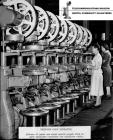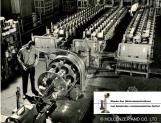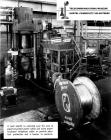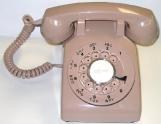2
After the war there was huge pent up demand for telephone service, because of war time restrictions. Northern Electric responded by building more and more cable. The volume was growing faster than plant capacity so a new cable plant was built in the Montreal suburb of Lachine. It churned out millions of feet of cable to meet the demand from all telcos.The paper insulator applied a loose layer of paper insulation over the wires prior to their twisting into pairs. Pairs have to be twisted to prevent one circuit cross-talking into another. Paper insulation was used from the earliest days of cable manufacturing and even though it was mostly displaced by pulp and plastic insulation, it continued to be used for submarine cable.
4
The strander takes a very large number of coloured insulated pairs and groups them into strands which eventually form binder groups. These are further grouped into the required number prior to application of the cable sheath.6
The lead press is used to apply a lead sheath over the cable pairs. This sheath prevents water and moisture from entering the cable and damaging the cable pairs, it also protects it from electro-magnetic interference. To ensure further protection from moisture cables are pressurized. Should the cable be punctured a pressure contactor operates to send an alarm to the telephone office.In the past technicians would use a device called a Wheatstone bridge to measure the resistance in order to determine the location of the break. They had to take into consideration the ambient temperature if the cable was aerial because copper wires length varies with temperature thereby impacting its resistance. Expert technicians could locate a cable fault usually within two telephone poles. Today, this is all achieved easily with the use of computerized test equipment.
Lead remained in use for the majority of applications till about 1956 when polyethylene replaced it. Lead continued to be used for special applications like submarine cable.
Cables became larger and larger, the largest pair count manufactured by Northern was a 4,200 pairs paper-pulp insulated cable. However, interoffice trunking demanded more and more circuits, it was not uncommon to see four or more of these very large cables on telephone posts. In cities with buried cables these proved to be a major challenge because cables had to be pulled into ducts, when available; another solution had to be found.
7
Cable CarrierCirca 1963
Montréal, Québec, Canada
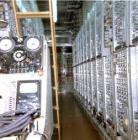 Credits:
Credits:Bell Canada Historical Collection
Ken Lyons
8
Carrier systems such as the N-1 combine 12 channels into two radio frequency signals that use two cable pairs. This provides a six-fold gain over voice-frequency. N-1 was introduced in 1948 between Montreal and Ste-Agathe, QC. It's interesting to note this system compresses high level signals to improve their transmission then expands them at the receiving end. This is exactly what Dolby did twenty years later for audio tape. The N-1 used six tubes per channel which as can be seen concentrated a very large number in a small space. These tubes produced a lot heat that required fans on each equipment bay for cooling.An exchange version of this carrier called NX-1 using transistors was used to increase cable capacity between telephone exchanges.
10
One of the specialized phones produced was the N9A Railway Phone, it replaced an earlier model housed in a wooden box that had a separate receiver and transmitter . It was carried on trains and by maintenance of way personnel to communicate with the nearest stations when needed. It was connected to wires on a long rod which ended in a "Y" at its top, which were hooked on to an open wire pair that ran along the tracks. By operating the press to talk switch on the handset user could talk to station operator.12
The model 500 telephone set, designed by Bell Labs in the USA and its housing designed by Dreyfuss, was introduced in 1952 to Bell in Canada. It replaced the bulkier 302 model. It has a more pleasing appearance, is lighter and in addition it allowed the user for the first time to adjust the loudness of the ringer. Initially since Bell still had many serviceable 302s they would only provide the newer model 500 to those customers where improvement to transmission occurred.The first ones did not have retractable handset cords, they had a black painted base with felt feet. This gave way to a zinc chromate plated base with rubber feet. By 1956 colour sets with retractable cords were introduced. Customers who could only rent sets from telcos paid a one time colour fee to obtain sets that were available in several colours such as: blue, avocado green, white, beige, red then later burnt orange and harvest gold.
This set proved extremely robust, it could be dropped with little or no damage. Maintenance was usually limited to replacing cords and occasionally transmitter capsules.
It was produced in hundreds of models to meet specific needs. It remained the standard set for 30 years.
14
In the early 1950s Step-by-Step switching was no longer meeting the higher traffic volumes and number of lines. It required far too much equipment and too much maintenance to be cost effective.A new switching system called cross-bar (X-Bar) was introduced. It used nearly half as much space as Step-by-Step and required significantly less maintenance as it didn't use electro-mechanical switches.
X-Bar required users to adapt to it because the called phone would not ring immediately after dialed. The system had to process the dialed number by the use of about 11 different massive frames of equipment that were each made up of hundreds of relays.
In the telephone office, where the Step system was quite noisy, for it was a constant noise, on the other hand the X-Bar made an aggressive noise because of the large number of relays operating simultaneously.
